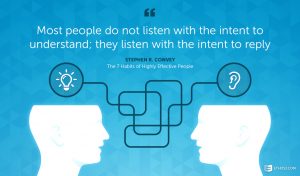I have always been told that I am a great listener. I do appreciate the compliment, but it made me curious; what makes someone a good listener, and how can I become an even better listener? I went to Google for answers and discovered the philosophy of Listening to Respond vs. Listening to Understand. Since presenters want people to listen, this philosophy can help presenters be better at listening.

Dating back to the 1940s, American educator Edgar Dale developed the Cone of Experience which broke out the percentages of which people retain information. Dale’s research found that we only remember 10% of what we read, 20% of what we hear and 30% of what we see. And now that we live in an age of smartphones and short attention spans, the art of listening is becoming more difficult. Presenters have to deal with distracted audience members almost always because of this.
But presenters can also be bad at listening to their audience as well. A 2010 Princeton University study found that there is a lag time between what we hear and what we understand. During this time gap, we begin to craft our response instead of paying attention to what is being said. In Stephen R. Convey’s The 7 Habits of Highly Effective People: Powerful Lessons in Personal Change, he says, “Most people do not listen with the intent to understand; they listen with the intent to reply.” Presenters can be guilty of this when they are taking questions or holding a discussion, and assume they know what their audience will ask instead of actually listening to the question.

This is where the practice of Listening to Understand can help presenters and audiences alike. Here are some ways to practice better listening and how it will help you be a better presenter.
New Experiences:
To be a better presenter, it is good practice to watch as many presentations as possible. Going to conferences and workshops is a great way to expose yourself to different kinds of presentations and presenters. But instead of taking all your notes while the speaker is on stage, wait until after it’s over to reflect. This way, you are fully engaged with the presenter the entire time he or she is speaking, and you can practice listening to understand.
The Big Picture:
After you watch other presentations, try to identify what the overall message was. One way to do this is to pinpoint the speaker’s 3 main points. Then, concentrate on identifying 3 main points for your next presentation. At Ethos3, we practice the Rule of 3 for Presentations which makes it easier for your audience to remember 3 takeaways. So, while you become a better listener to others, your audience will also easily remember your presentation.
Body Language:
One way to make sure your audience is still with you throughout your presentation is to take a moment and analyze their body language. Is there eye contact? Are people yawning? Or looking around? Being aware of your audience’s physical appearance can help you take control over your presentation before it’s over. Stop and ask for questions. Or speak up louder and more lively to grab back the attention. It’s also important to be aware of your own body language while you speak, so your audience is comfortable watching you.
After I did my research on Listening to Understand, I now make an effort with each conversation to be more aware of my thoughts. When I catch myself forming a response in my head, I stop and focus again on what the other person is saying. While it is important to come up with answers, it is also important to really hear what is being asked or said. By simply becoming more aware, presenters can become better listeners to both other presenters and their audience.
Related Posts:
Presentation Truths: Listen More Than You Speak